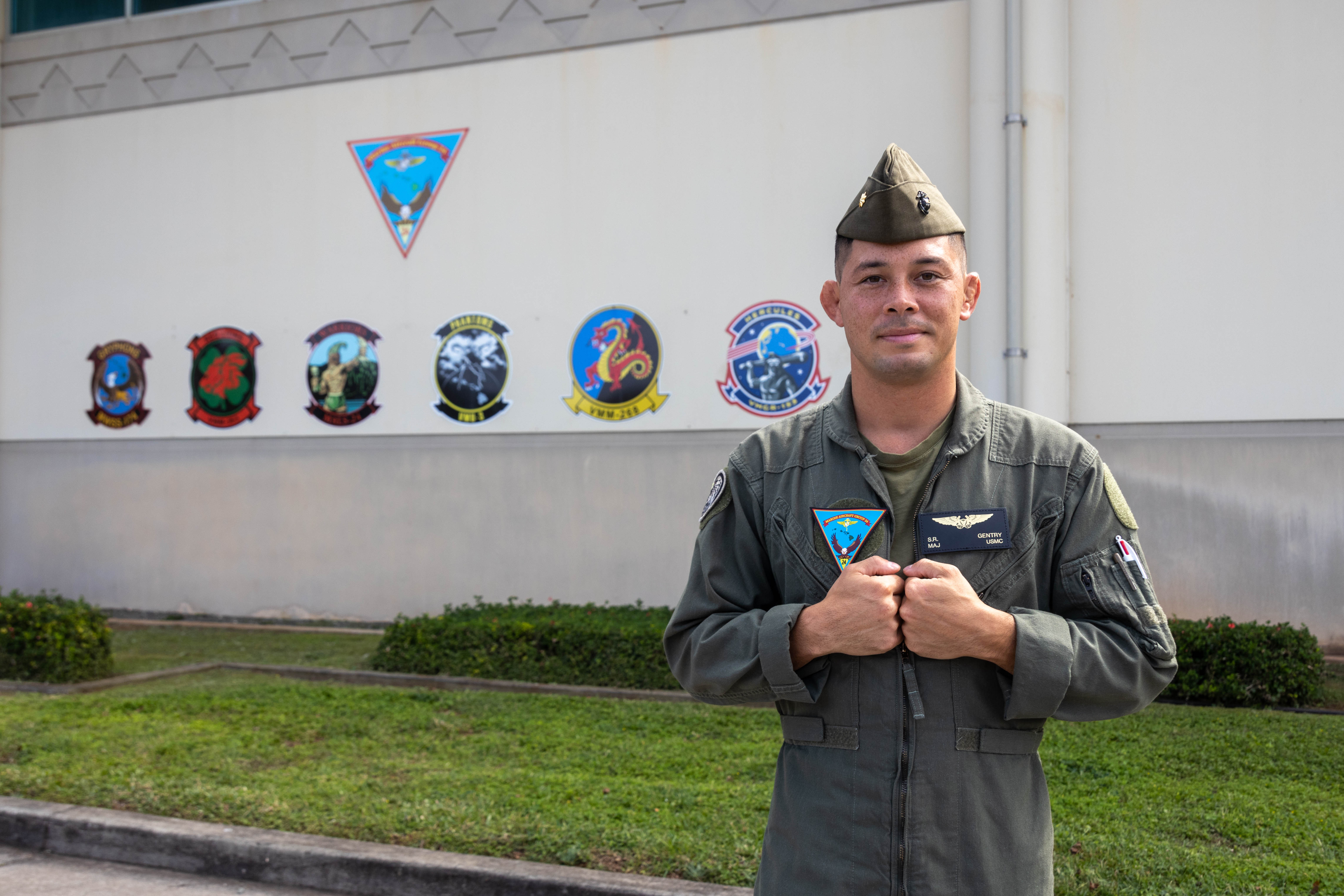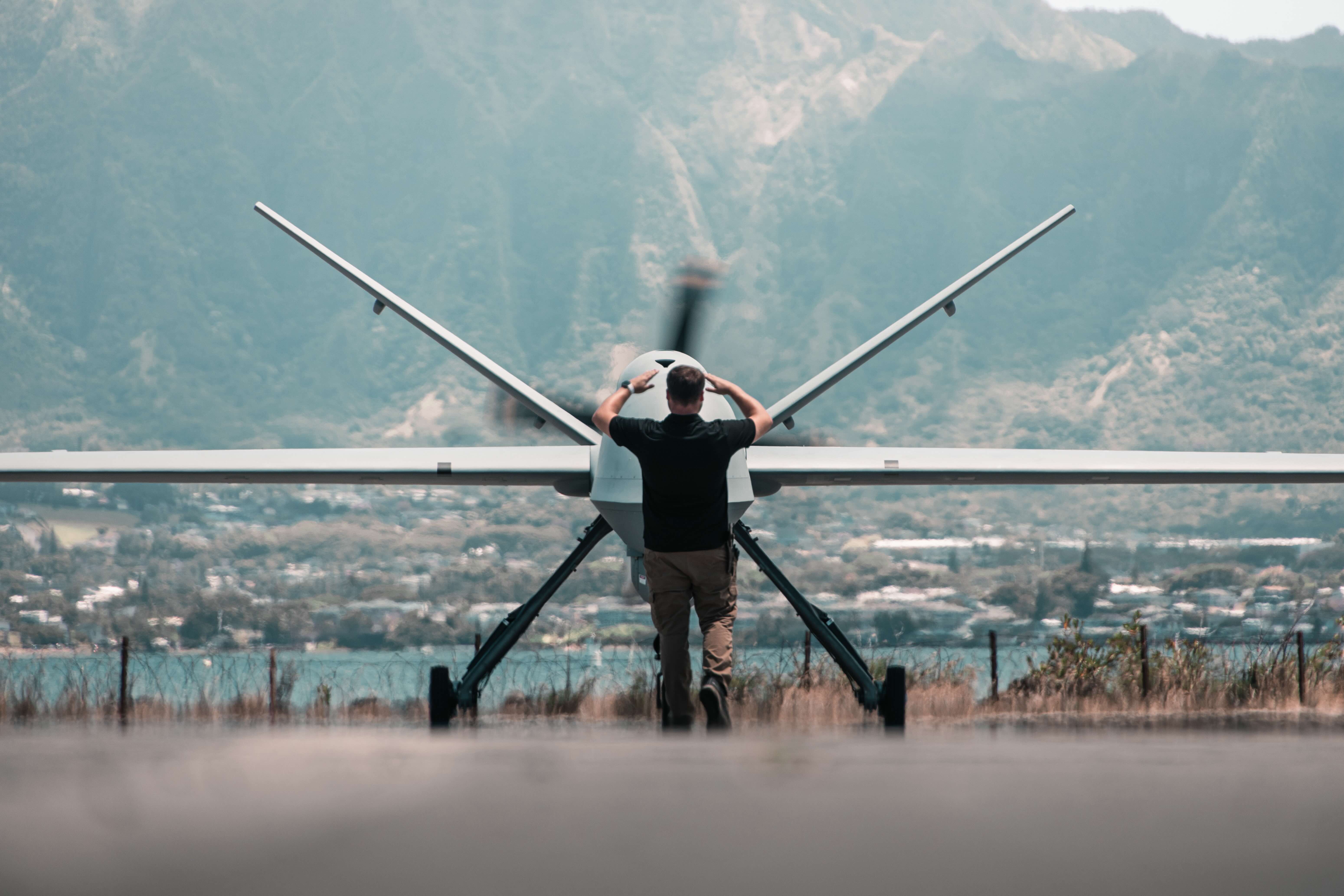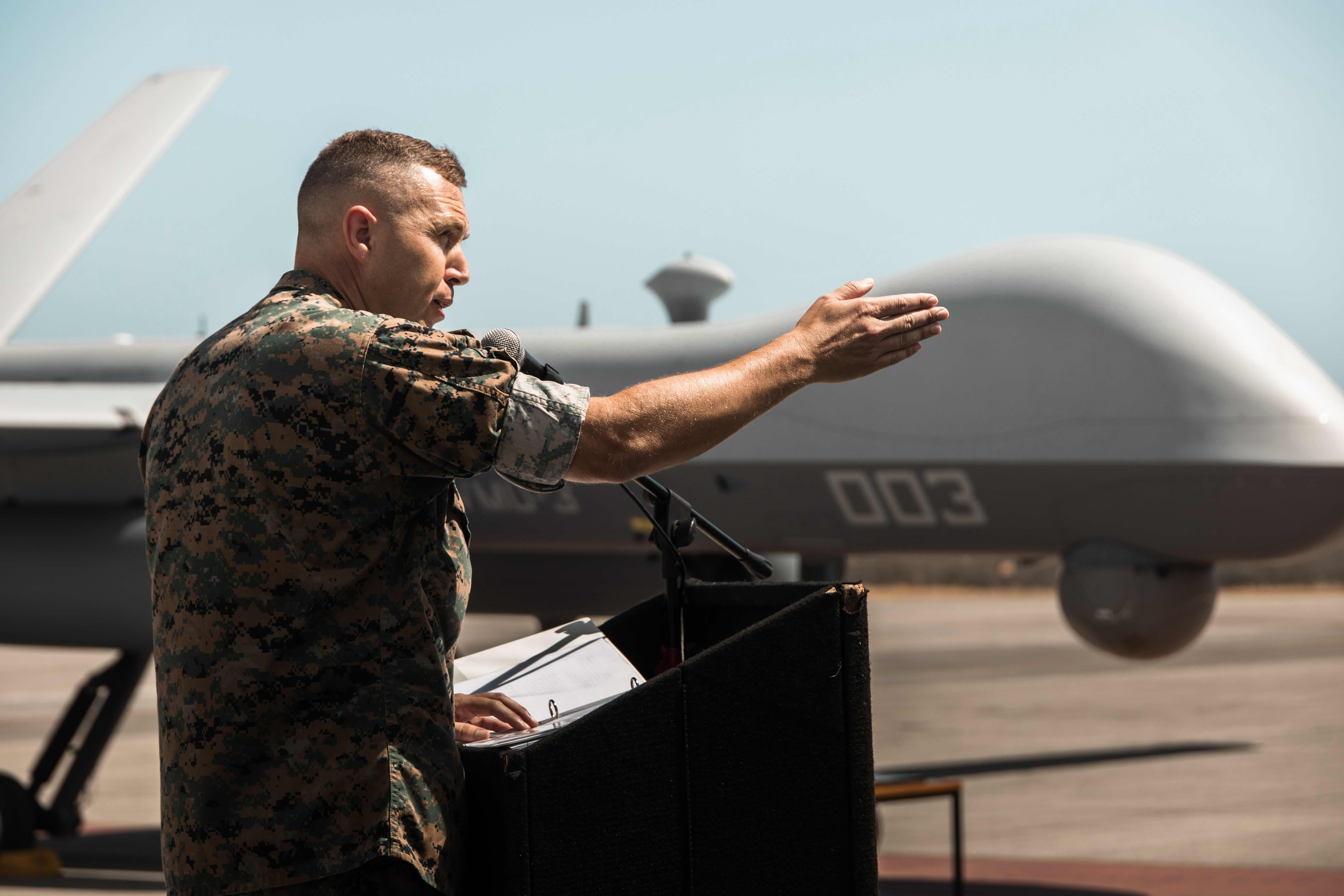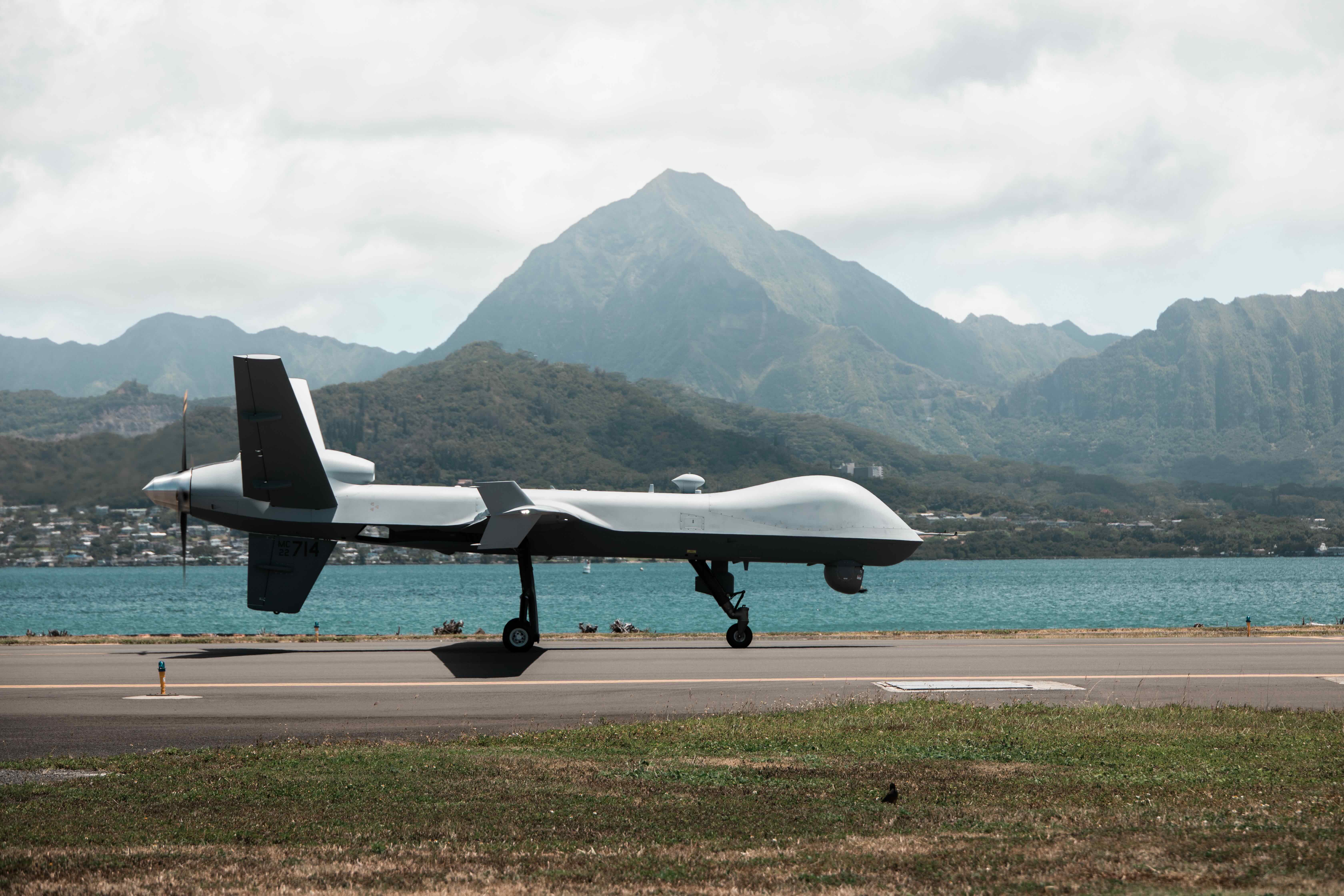
Nearly a decade ago, as a new officer, Maj. Shane Gentry mulled over his Marine Corps job options, including three slots for unmanned aircraft systems training open to his Basic School class.
Curiosity about new technology and the desire to deploy drew Gentry into the service’s fledgling UAS pilot community. He knew the Marine Corps’ unmanned systems squadrons “were the most deployed units at that time. That’s something I wanted to do,” he said.
He knew about hand-held drones and big, loitering ones, but “I really wasn’t sure what UAS was,” he added. “I really didn’t know what I was getting into.” His career so far includes piloting the RQ-21 and RQ-7B, then the MQ-9A with Marine Unmanned Aerial Vehicle Squadron 3 supporting operational units overseas during a “combat embed” last year.
Last month, Gentry was home in Hawaii when he learned – via early-morning congratulatory texts from friends on the East Coast – of his selection as “Marine Aviator of the Year” for 2024. The corps also announced last month that he’ll receive the Alfred A. Cunningham Award, one of the service’s Marine Corps Aviation Association annual recognitions. Gentry and other award winners will be recognized at the 52nd Annual MCAA Symposium in Dallas, Texas, next month.
“I never thought I’d be a recipient of the award,” said Gentry, a third-generation Marine currently assigned to Marine Aircraft Group 24, 1st Marine Aircraft Wing at Marine Corps Base Hawaii.
The Cunningham Award is the service’s highest honor for pilots. Considered the pioneer of Marine aviation, Cunningham was a young lieutenant and aeronautic aficionado who became the first Marine aviator in 1922. He flew combat missions in Europe in 1918, earned the Navy Cross and retired as a lieutenant colonel.
Until this year, the top honor has been given to naval aviators who have piloted manned aircraft, including fighter jets and attack helicopters. According to the Marines, he’s the first drone pilot to receive the Cunningham Award.
“We’re a very small community,” Gentry said. “I’m extremely proud to represent MAG-24 and 1st MAW.” The award “is a testament to the work and effort that’s being done every day by the Marines. It’s a great honor, it’s humbling – absolutely pioneering for the Marine Corps unmanned community.”
Gentry said his award is less about his individual actions and more about “the substantial efforts” of the Marines, sailors and airmen at VMU-3, who “have made measurable differences, leaps and bounds over this last year to get VMU-3 to the point where we are at now. And by no means are we at our end state.”
“Measurable differences are being made almost daily,” he added.
The award highlights “the importance of the unmanned community in Marine Corps aviation,” he added, noting the first Cunningham Award recipient was another pioneering Marine: Lt. Col. John H. Glenn, Jr., in 1962.
“Marine Corps aviation has continually developed and redefined the application of aviation in the conduct of warfare,” Gentry said. “The development of today, like with unmanned aviation, is really not too different than what we saw with the introduction of flight into air reconnaissance in World War I, introduction of close-air support during the Korean War, introduction of rotary-wing into the fight during Korea and Vietnam and fast forward… now into the 2020s, Marine Corps unmanned aviation.”
The advent of drones and other unmanned, uncrewed systems reflects added capabilities and depth to Marine aviation as it continues to evolve, he said.
“We’re not coming to take like manned aviation jobs,” he said. “If anything, we’re enhancing lethality of the aviation enterprise. We’re enhancing survivability of the manned aircraft, we’re enhancing their roles and duties in aviation. So we are an enhancing aspect of Marine Corps aviation. It’s a teamed effort. The manned-unmanned team is going to be the difference as we move forward to our future conflict.”
More honors for UAS

This year’s MCAA awards reflect the shifting face of Marine Corps aviation as its UAS capabilities grow and the aviation community transitions to support both ground and air units, as well as Marine Corps air-ground task forces.
“This is a great year for the VMU community,” Gentry said.
He noted that the award he’s receiving is one of five Marine Corps individual and unit awards going to the UAS community for their work in the past year.
“There’s been a lot of recognition to our virgin community,” he said, “all indicative of the Marine Corps aviation enterprise rewarding adaptation, innovation, recognizing the progress which is being made in the community.”
The other four UAS recipients of this year’s MCAA awards include:
- Sgt. Spencer G. Neitzke with Marine Test and Evaluation Squadron 1 (VMX-1), who will receive the Gaines B. Gilbert Award as the 2024 Aviation Ordnance Marine of the Year.
- Capt. Scott A. MacDonald, VMU-1, who will receive the James Maguire Award for Exceptional Achievement.
- VMU-1, based at Yuma Marine Corps Air Station, Ariz., will receive the John I. Hudson Award as the 2024 Marine Unmanned Aerial Vehicle Squadron of the Year. The award, Gentry said, recognizes its support to combat contingency operations in U.S. Central Command.
- Lt. Col. Leigh G. Irwin with PMA-266 , the multi-mission tactical UAS program office at Naval Air Systems Command, was named Acquisition Officer of the Year Award and received the Michael A. Hough Award for acquisition excellence in Marine aviation.
Gentry also pointed out that Cpl. Jude D. Dooling, who is assigned to VMU-3, in February was named the Intelligence Enlisted Marine of the Year for 2023.
“Each award has significant meaning on its own,” Gentry said. “But the Marine Corps has awarded our community five recognitions of achievement. That’s a sign of the tremendous effort… across the community.”
Evolving missions

The Marine Corps has leaned in to testing and adopting uncrewed air and ground systems to support operational forces in the future fight. Its small but growing fleet of MQ-9As is replacing the legacy, Boeing/Insitu-made RQ-21A Blackjack unmanned air vehicle, which began operations a decade ago for the Navy. It has replaced the Marine Corps’ older RQ-7B Shadow UAV, which flew missions in Afghanistan and Iraq.
Larger than those predecessors, the General Atomics-built, remotely-piloted MQ-9A is classified as a Group 5 UAS. The MQ-9A is expected to support intelligence, surveillance, reconnaissance and targeting missions, along with maritime domain awareness, airborne network extension, airborne early warning, and electronic support. It can travel 1,600 miles and remain airborne for over 20 hours.
The Marine Corps calls its system MUX/MALE, or Marine Air-Ground Task Force Unmanned Expeditionary Medium-Altitude, High-Endurance. “It’s not a Reaper,” said Gentry, noting its role and function differ from the Air Force, the first to operate the system.
VMU-1 at Yuma became the first Marine unit to operate it in 2018 under a contractor agreement. Last year, the Marine Corps received its first of eight MQ-9s under a joint contract with the Air Force, and VMU-3 got its first two aircraft and became the Corps’ first operational MQ-9A squadron in August and will continue to grow to a squadron of about 250 Marines, said Gentry. Maintenance currently is done by contractors.
This week, the Marine Corps marked the delivery of the first MQ-9A Reaper built to join the “Night Owls” of Marine Unmanned Aerial Vehicle Training Squadron (VMUT-2) at Cherry Point MCAS, where it falls under 2nd Marine Aircraft Wing. Lt. Col. Michael Donlin, the squadron commander, said in a Marine Corps news story that the arrival “is yet another successful milestone in the transition of VMUT-2 to become the MQ-9A Fleet Replacement Squadron, responsible for the world-class training of the Marine Corps’ MQ-9A pilots and sensor operators.”
Combat embeds

The Marine Corps currently has two operational MQ-9 squadrons: VMU-1 and VMU-3. and the training squadron at VMUT-2 is building schoolhouse capacity to train MQ-9A pilots and sensor operators.
Gentry said his training pipeline “was not standard,” noting changes in recent years as the service builds its Group 5 capabilities.
He began training as a UAS pilot in 2014, attending Air Force and Air National Guard courses as the small community was evolving and the Marine Corps eyed expanding from mid-sized Group 3 systems to the larger Group 5 UAS. He joined Marine Unmanned Aerial Vehicle Squadron 2 at Cherry Point, N.C., in 2016 and operated the RQ-21 in shipboard deployments with the 26th Marine Expeditionary Unit and Marine Aircraft Group 29. Operating the RQ-21 meant training alongside ground units, “supporting ground scheme of maneuver at the tactical level,” he said.
In 2020 he joined VMU-3 at Kaneohe Bay, Hawaii. He began training on the MQ-9A in 2021. The larger aircraft, which fly faster and higher and have longer range, are handled differently than the smaller Group 3s.
The MQ-9A is operated by a pilot and a sensor operator. The pilot is in charge of physical manipulation of the aircraft and its payloads,” Gentry said. “The sensor operator is working non-flight critical aspects of the aircraft,” including cameras and sensors, and communication is shared among both. Unlike with Group 3s like the RQ-21, “the roles are not interchangeable,” he added.
Deployments for the MQ-9 community can mean duty in the continental U.S. or overseas. So far Gentry has completed two “combat embeds,” as they are called, supporting combat operations.
He flew the MQ-9 with the 138th Attack Squadron of the 174th Attack Wing of the New York Air National Guard in Syracuse, N.Y., in 2020-2021 for a six-month combat embed, “learning MQ-9, doing remote combat operations there,” he said. After working MQ-9 transitioning with VMU-3, Gentry deployed with a group of four Marines to the Nashville-based 105th Attack Squadron of the 118th Attack Wing of the Tennessee ANG in January 2023 for five months. ,.
Gentry said he was “super fortunate” to have had such deployment opportunities and, so far, estimates he’s flown 1,500 to 2,000 hours. That includes 550 combat hours, with 420 of those flying 80 sorties or “combat lines” on his 2023 combat embed. “Nearly all of it is forward in support of a combatant command mission with crews that are trying to make measurable effects every day,” he said.
“It’s a little bit different mentality and mindset” than being out in field exercises with Group 3 UAS, he said. With the long reach of Group 5 drones, “you can do multiple combatant commands in a week… [for] different supported units. Definitely a unique perspective.” The routine of operating drones with longer loitering times also differs from using Group 3 systems.
“I’m really excited to see where the MQ-9 program is in a year or two,” Gentry added, noting “there are great successes happening at the Group 1 and Group 2” levels and with unmanned logistics and tactical air.
Gentry, who was promoted to major in February, will attend the Marine Corps Command and Staff College in Quantico, Va., this summer.





